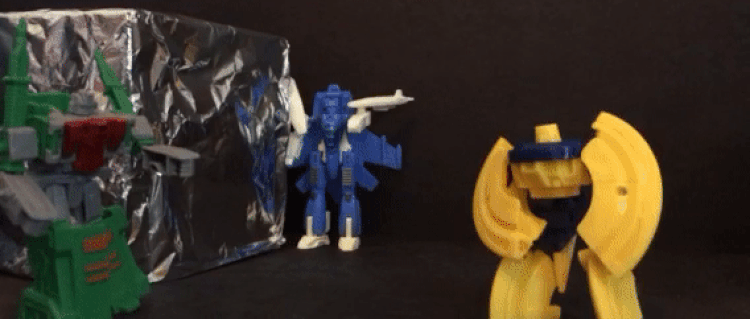Fights are not “resolved” in Accelemechs vs. Crashotrons. You never roll dice or calculate a result. Instead, fights happen through the physical action of the toys and the players. That is not a concession or a compromise; it is not “dumbing the game down” for the sake of fast play. To the contrary, playing in the physical world allows you to access, manipulate, and exploit the most complete and detailed physics engine around–actual physics.
Here are some things that I’ve seen happen in AvC playtests:
- Ricochet hits
- A hit target falls into a teammate, knocking the teammate down
- Terrain shifts under hard blows, changing the battlefield in real time
- Players intentionally hitting terrain for the purpose of shifting it
These are all things that could happen in the real world, but that even complex wargames generally don’t try to simulate. It would be agonizing to work out the ricochet angle for every miss. No one wants stop play while establishing whether a wall fell over in such a way as to create useful cover.
When playing in the physical world, though, you get all of that stuff for free. If your pieces can take cover behind the fallen wall, you’ll see that it’s so. If a ricochet would hit something, it will. Issues that usually have to be abstracted away become a natural part of the game.
The bigger gain in my mind, though, is how much easier things that are included in wargames become. Issues like the effects of difficult terrain are so clearly important that every wargame has to take them up. Normally this means either jarring abstractions or fiddliness–all of which goes away instantly when actually moving across a real surface.
For example, we all know that it’s difficult for a car to drive on surfaces other than pavement. How far, then, can a general’s staff car in World War II go when moving across the broken ground of Normandy after D-Day?
Perhaps the most common rule is that vehicles move at half speed when not on a paved surface. Thus, if the car normally moves six hexes, or 6″, it would move 3 hexes or 3″ when taken off-road.
That works well enough so long as we only care about cars, and the only surfaces are paved roads and dirt. Infantry, though, requires more detail than “dirt;” people might still make good time over dry, packed soil, but get much slower moving through mud or a thickly-planted field of high corn. Tanks may go right through the corn, but be slowed by the mud (how much?). And we haven’t considered the possibility that “dirt” could include ditches that a car might get stuck in.
Or, instead, of all of that, try this: put a toy car on some dirt, choose a destination, and give it a push in the right direction. Did it make it where you meant it to go? Did it get stuck? Did it get slowed down by the dirt, and not quite go all the way? Did it hit a rock, and flip over? All the issues one normally needs rules for–all the possibilities that the rules would need to address (or, more likely, not be able to address)–are handled for you, right there in the moment with no die-rolling or table lookups required.
If this sounds like a sales pitch, it’s because I really am selling. Not just Accelemechs vs. Crashotrons–though of course, I certainly hope you buy my game–but the experience of real-physics wargaming in general. People have been doing this at least since H.G. Wells’ Little Wars, and it’s amazing! It’s something I really, really think you should try–and if you want to have a go, AvC releases on Saturday!



